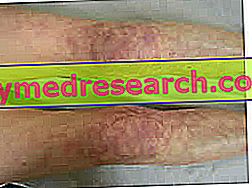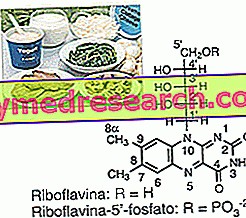Generality
Cryoglobulinemia is a form of systemic vasculitis, characterized by the presence, in the blood, of immune complexes that precipitate at the base temperatures. These immune complexes are known as cryoglobulins.

The diagnosis must be accurate and also aimed at finding the causes that caused the cryoglobulinemia. In fact, only in this way is it possible to plan the most appropriate therapy, which is solely pharmacological.
Brief reminder of what antibodies are
Antibodies, or immunoglobulins, are globular proteins that play a fundamental role within the immune system : they, in fact, allow us to fight foreign microorganisms (called antigens), which infect our organism.
Immunoglobulins are secreted by B lymphocytes, which are immune cells, and act as their surface "antennas". In the presence of an antigen, the antibodies located on the membrane of B lymphocytes are activated, signaling to the B lymphocyte itself to produce other specific immunoglobulins against the detected antigen. From this moment on, the defensive barrier, erected by our immune system, becomes increasingly powerful and effective. In fact, the production of a large number of antibodies, circulating in the blood, makes it possible to trace the antigens and destroy them.
Antibodies (which act as simple signalers or labels) are concerned with the destruction of the antigen, but other elements of the immune system: phagocytes and cytotoxic cells .
There are 5 types of immunoglobulins: IgM, IgA, IgE, IgG, IgD.
What is cryoglobulinemia?
Cryoglobulinemia is a systemic vasculitis that mainly involves small blood vessels, characterized by the presence in the blood of cryoglobulins .
Cryoglobulins are protein aggregates, composed of antibodies and antigens (antigen and antibody, joined together, form the i mmunocomplessi ), which have the particular characteristic of precipitating at low temperatures. It is this latter peculiarity that distinguishes cryoglobulinemic vasculitis from other forms of vasculitis, always caused by immune complexes.
The effects of cryoglobulinemia are numerous and can occur at multiple levels: skin, joints, nerves, kidneys, heart, brain and gastrointestinal tract are all districts at risk.
WHAT IS A VASCULITE?
A vasculitis is a general inflammation of the blood vessel wall, both arterial and venous. This inflammatory state may arise for unknown reasons ( primary vasculitis ), following autoimmune reactions, due to a pathogenic infection or, finally, due to another more important pathology ( secondary vasculitis ).
In the case of cryoglobulinemia vasculitis, the involvement of the immune system is evident (think of the formation of the antibody aggregates), but not only. In fact, as we will see later, the hepatitis C virus and some blood cancers represent two of the main causes.

Figure: the cryoglobulins, at 4 ° C, fall to the bottom of the tube, containing the serum extracted with a blood sample.
From the site: www.mja.com.au
Epidemiology
Cryoglobulinemia is widespread in southern Europe and usually affects individuals between the ages of 40 and 60. It has a particular preference for the female sex, as the ratio females: males is 3: 1.
As will be seen in the chapter dedicated to causes, cryoglobulinemia is linked to the hepatitis C virus : in fact, more than 90% of the patients affected were previously infected with this virus; however, it must be specified that only 3% of viral hepatitis C patients develop cryoglobulinemia during their lifetime.
Causes
The pathogenetic mechanism that causes cryoglobulinemia is the formation of abnormal immune complexes in the blood vessels; the consequent deposition of these immune complexes on the vessel wall triggers an inflammatory reaction responsible for the vasculitis.
But what are the causes that set this mechanism in motion?
The causes can be different; they range from viral infections to autoimmune diseases and blood cancers.
In detail, we are talking about:
- Viral infections :
- Hepatitis C
- Autoimmune diseases :
- Rheumatoid arthritis
- Sjögren syndrome
- Systemic lupus erythematosus
- Blood cancers :
- Some lymphomas
- Multiple myeloma
- Waldenström's macroglobulinemia
TYPES OF CHRYGLOBULINEMIA
According to the so-called Brouet classification, there are three types of cryoglobulinemia; below is a table that describes the general characteristics and causes.
Guy | Percentage of cases | Description |
| Type I, or simple cryoglobulinemia | 10-15% | Cryoglobulins are made up of a single monoclonal immunoglobulin, usually IgM, often IgG or IgA without activity of factor reumatoidede (FR). The triggering causes are usually multiple myelomas and Waldenström's macroglobulinemia. |
Type II | 50-60% | Cryoglobulins are composed of immunoglobulins of several classes, one of which is monoclonal (generally IgM with rheumatoid factor - RF) activity. The main cause is the hepatitis C virus. |
Type III | 25-30% | Cryoglobulins consist of one or more classes of differently associated polyclonal immunoglobulins. The most frequent association is IgM-IgG, with igM having rheumatoid factor activity towards IgG. Possible triggers can be: hepatitis C virus, rheumatoid arthritis and systemic lupus erythematosus. |
Type II and type III cryoglobulinems belong to the class of mixed cryoglobulinemias, as the cryoglobulins are composed of different types of antibodies.
Symptoms and Complications
The symptomatology of cryoglobulinemia is very varied and is influenced by the causes.
Generally, most patients report a feeling of weakness and fatigue, with aching muscles and joints ( arthralgia or arthritis ).

Figure: signs of purpura: spots and ulcerative sores. From the site: www.medicscientist.com
The cutaneous signs of vasculitis consist, almost always, in purpura : this is usually characterized by circular spots of variable size, sometimes painful and itchy; however, it is possible that real ulcerative sores may also form.
When there is nerve involvement (infrequent, but still possible), situations of paresthesia and peripheral neuropathy arise, characterized by numbness, tingling in the hands, burning pain and weakness in the legs.
At cardiac level, the possible manifestations are: heart attack (with chest pain, dyspnea, heartburn etc.) and congestive heart failure (with difficulty breathing and swelling of the lower limbs).
In the brain, strokes, mini strokes and strong headaches can occur.
Finally, the possibility of observing the so-called Raynaud's phenomenon, pains in the abdomen of variable intensity and some renal disorders, such as membrano-proliferative glomerulonephritis, should also be mentioned; the latter, in particular, are very subtle, as they appear only at an advanced stage, not before.
Specific symptoms of type I cryoglobulinemia
| Specific symptoms of type II and III cryoglobulinemia
|
Symptoms of cryoglobulinemia, from the most frequent to the least frequent:
|
COMPLICATIONS

Figure: Reynaud's phenomenon.
The appearance of complications depends more on the pathologies that cause the state of cryoglobulinemia, than on the cryoglobulinemia itself. The situation gets worse, in fact, when blood tumors, autoimmune diseases or hepatitis C are at an advanced or chronic stage.
Diagnosis
To diagnose cryoglobulinemia, you can proceed in several ways.
The most indicative and characteristic test is to see how the patient's blood reacts at low temperatures . To do this, obviously, a simple withdrawal is needed; in the case of cryoglobulinemia, precipitation of the antibodies on the bottom of the test tube occurs, which appear as a solid mass.
The only drawbacks of this test are related to the identification of the ideal temperature (which is 4 ° C) to observe the phenomenon: many of the false-negatives, in fact, are due precisely to an incorrect choice of temperature.
Precipitation times are several hours, if not days; for example, type I takes a maximum of 24 hours, while type III may take up to a week.
OTHER CHECKS
Biopsy . Many patients, suspected of suffering from cryoglobulinemia, undergo several biopsies: of the skin, nerves and kidneys. The biopsy consists in taking a sample of cells (from a tissue or from an organ), which will then be observed under a microscope; based on the characteristics of these cells, the doctor can determine whether or not there is cryoglobulinemia.
Rheumatoid factor . Type II and III cryoglobulinemia is characterized by a positive rheumatoid factor.
EXAMINATION OBJECTIVE
Physical examination is important and provides much information, however the symptoms and signs of cryoglobulinemia are common to other disease states.
SEARCH FOR CAUSES
The identification of the triggering causes is very important, because it allows the doctor to plan the most appropriate therapy. For example, it is very common to subject the patient, with established cryoglobulinemia, to specific tests for viral hepatitis C, as this is found in 90% of cases.
Treatment
The choice of the most appropriate therapy depends on the causes that caused the cryoglobulinemia.
Here, then, that specific anti-viral drugs can be taken alongside anti-inflammatories (essential for reducing inflammation), if there is a viral hepatitis C or immunosuppressive drugs, if an autoimmune disease is underway .
The following are the most commonly administered medicines in cases of cryoglobulinemia and a brief description of why they are taken.
Anti-viral drug therapy . As said, it is realized if at the base of the cryoglobulinemia there is a proven viral hepatitis C. Anti-viral drugs are widely used by patients with cryoglobulinemia, as this, in 90% of cases, is due to the hepatitis C virus.
Immunosuppressant therapy . Immunosuppressants reduce the inflammatory state of vasculitis; to do this they act on the immune defenses, which, especially in the case of autoimmune diseases, are exaggerated and cause serious damage to the body (arthritis, arthralgia, Reynaud's phenomenon, etc.). Cyclophosphamide, azathioprine or methotrexate belong to this category of medicines. Immunosuppressant therapy exposes the patient to an increased risk of infections.
Corticosteroid based therapy . Corticosteroids are powerful anti-inflammatories, which are taken to reduce the effects of vasculitis, kidney and neurological disorders and purpura. These drugs can cause numerous side effects and this explains why they are given at the lowest effective dose. In patients suffering from cryoglobulinemia, the most widely used corticosteroid is prednisone .
Non-steroidal anti-inflammatory drug therapy (NSAID) therapy . NSAIDs, as the name implies, reduce inflammation. They therefore represent an alternative to corticosteroids: compared to these they are, on the one hand, less effective and, on the other, have less side effects.
Rituximab based therapy . Rituximab is a monoclonal antibody, which reduces B lymphocytes, or immune cells secreting immunoglobulins.
COLD ENVIRONMENTS
The doctor advises patients with cryoglobulinemia to avoid very cold environments, at least until the problems have improved.
Prognosis
Prognosis, like treatment, depends on the causes of cryoglobulinemia and, moreover, on how far these triggering circumstances have advanced. For example, if blood cancers are very serious or hepatitis C is chronic, the outcome can only be dramatic, as all the most dangerous disorders (kidney damage, heart attack, neuropathies, etc.) are difficult to cure.
Pharmacological treatments also deserve special attention: some may, in fact, cause different side effects, especially if they are badly used. Therefore, it is a good idea to carefully follow the doctor's advice regarding doses and any variations, and undergo periodic checks to monitor the evolution of cryoglobulinemia.



